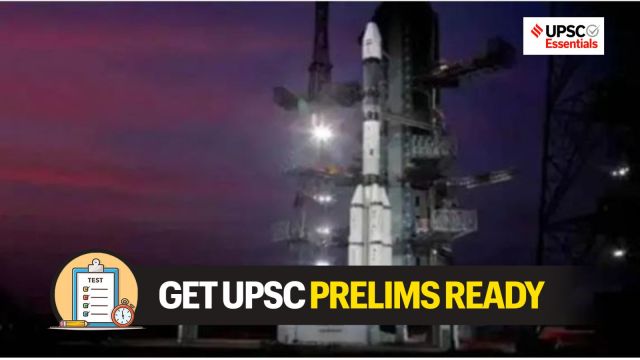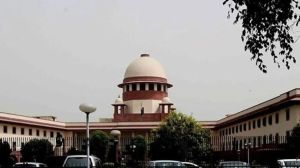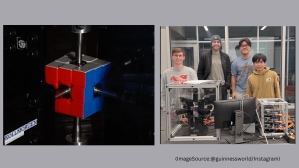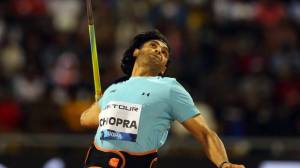UPSC Prelims 2025 Special: Revision Checklist for important Science and Technology topics that aspirants shouldn’t miss
UPSC CSE Prelims 2025: Sci-tech current affairs often carry high weightage in UPSC Prelims, making them crucial for scoring above the cutoff. With the Civil Services Preliminary Exam 2025 just around the corner, here’s a quick checklist of key Science and Technology topics. Are they in your revision notes? Take a look.
 Here’s a must-check list of key Sci-Tech topics to revisit in your notes or compilations. Don’t miss them during your final revision.
Here’s a must-check list of key Sci-Tech topics to revisit in your notes or compilations. Don’t miss them during your final revision.Are You Prelims Ready? The UPSC Civil Services Preliminary Examination 2025 is scheduled for May 25. With the clock ticking, revising Current Affairs—especially in Science and Technology—is crucial for every aspirant. Here’s a must-check list of key Sci-Tech topics to revisit in your notes or compilations. Don’t miss them during your final revision.
FYI: Check out our latest Environment revision checklist for UPSC Prelims 2025. (Click here)
1. Nobel Prizes
— Physics: The Nobel Prize in Physics 2024 has been awarded to John Hopfield and Geoffrey Hinton. They have been awarded “for foundational discoveries and inventions that enable machine learning with artificial neural networks.” Interestingly, both the Physics and Chemistry Nobel prizes this year have been given to artificial intelligence related research.
— Chemistry: The Nobel Prize in Chemistry 2024 has been awarded to David Baker, Demis Hassabis and John M Jumper. While Baker (62) won “for computational protein design”, the American Jumper (39) and Briton Hassabis (48) were honoured for “protein structure prediction”.
— Medicine: Nobel Prize in Physiology or Medicine 2024 has been awarded Victor Ambros and Gary Ruvkun “for the discovery of microRNA and its role in post-transcriptional gene regulation.”
To read more: Knowledge Nugget of the day: Nobel Prize in Chemistry and Physics 2024, Knowledge Nugget of the day: Nobel Prize in Medicine 2024
2. CAR-T cell therapy
The clinical trial results of India’s first CAR T-cell therapy, published in The Lancet, show that it worked for nearly 73 per cent of patients.
What is CAR-T cell therapy?
— CAR-T cell therapy, chimeric antigen receptor T-cell therapy, is an immunotherapy-based cancer treatment that uses the power of a patient’s own immune system to fight cancer. The immune system is the body’s defence network against infections and diseases. White blood cells (WBCs) play a pivotal role in the immune system.
WBCs, or leukocytes, are produced in the bone marrow and circulate in the blood and lymphatic system. The key types of WBCs include:
i) Neutrophils – Engulf and destroy pathogens
ii) Lymphocytes – Target specific invaders and remember past infections
iii) Monocytes – Differentiate into macrophages and dendritic cells, ingesting pathogens and presenting antigens
iv) Eosinophils – Release enzymes and toxic proteins that kill parasites and modulate inflammatory responses, and
v) Basophils – Release histamine and other chemicals that contribute to inflammation and allergic symptoms.
What are T-Cells?
— T-cells are primarily used in CAR-T cell therapy because of their pivotal role in the immune system’s response to pathogens and malignancies. These cells can be genetically engineered to express chimeric antigen receptors (CARs), which are specifically designed to recognise and bind to antigens on the surface of cancer cells. Once bound, these modified T-cells can efficiently kill cancer cells.
— Other cells like B cells or natural killer cells also play roles in immunity but don’t have the same adaptability and memory capabilities as T cells, making them less effective for the persistent and targeted action required in CAR-T cell therapy.
To read more: CAR-T cell therapy: What is it and how does it work, CAR-T cell therapy: Challenges and possible solutions
3. Anti-microbial resistance
— Antimicrobial resistance (AMR) is a condition in which bacteria, viruses, fungi and parasites no longer respond to antimicrobial medicines, which include antibiotics, antivirals, antifungals and antiparasitics. As a result, infections become difficult or impossible to treat, increasing the risk of disease spread, severe illness, disability and death. It is the result of evolution of microbes in a situation where there is a misuse or overuse of antibiotics.
— According to the World Health Organisation, Antibiotic resistance occurs when bacteria change in response to the use of antibiotics. Bacteria, not humans, become antibiotic resistant. These bacteria may then infect humans and are harder to treat than non-resistant bacteria. Antimicrobial resistance is a broader term, encompassing resistance to drugs to treat infections caused by other microbes as well, such as parasites (e.g. malaria), viruses (e.g. HIV) and fungi (e.g. Candida).
— AMR is a condition in which a pathogen can survive and cause infection despite the presence of an antimicrobial treatment. AMR is the result of microbial evolution in response to antibiotic abuse or overuse.
— Excessive use of antimicrobial medications can result in resistant or extremely resistant superbugs that can spread in hospitals, drinking water, and sewers. These microorganisms produce infections that do not respond to regularly recommended antibiotics.
To read more: UPSC Issue at a Glance | Antimicrobial Resistance and India
4. BioE3 Policy
— The Centre unveiled its BioE3 (Biotechnology for Economy, Environment and Employment) policy. It appears to be a routine attempt to create incentives and opportunities to energise growth in the biotech sector.
— The BioE3 Policy aims to establish a framework that ensures the deployment of cutting-edge advanced technologies while also aligning innovative research to promote biomanufacturing.
— The BioE3 Policy aims to accelerate the development and commercialisation of bio-based product technologies by establishing BioEnablers throughout the country, including Bio-Artificial (Bio-AI) Intelligence Hubs, Biofoundries, and Biomanufacturing Hubs.
— Bio-AI centres will be established to support research and innovation in the development of technologies for bio-based products throughout the specified thematic sectors/subsectors of biomanufacturing, leveraging data-driven research and AI-informed predictive analytics.
— Based on the National Consultation meeting and inter-ministerial discussions, six theme areas and sub-sectors of national importance have been prioritised for implementation under the BioE3 policy. These include (i) bio-based chemicals and enzymes, (ii) functional foods and smart proteins, (iii) precision biotherapeutics, (iv) climate-resilient agriculture, (v) carbon capture and utilisation, and (vi) future marine and space research.
5. Hydrogen fuel cell
— The government has formally approved the National Green Hydrogen Mission, with a stated aim of making India a global hub for the production of green hydrogen.
— According to the US Department of Energy, fuel cells work in a similar manner to conventional batteries found in electric vehicles but they do not run out of charge and don’t need to be recharged with electricity. They continue to produce electricity as long as there is a supply of hydrogen. Just like conventional cells, a fuel cell consists of an anode (negative electrode) and cathode (positive electrode) sandwiched around an electrolyte.
— Hydrogen is fed to the anode and air is fed to the cathode. At the anode, a catalyst separates the hydrogen molecules into protons and electrons and both subatomic particles take different paths to the cathode. The electrons go through an external circuit, creating a flow of electricity that can be used to power electric motors. The protons, on the other hand, move to the cathode through the electrolyte. Once there, they unite with oxygen and electrons to produce water and heat.
Read more about advantages and application of Hydrogen fuel cell: Union Cabinet approves Green Hydrogen Mission: A look at India’s push for the fuel, What is hydrogen fuel cell technology, how will work?
Also read: Zinc-Air Battery
6. Small modular reactor
— The government in Union Budget 2025 announced a Nuclear Energy Mission for research & development of Small Modular Reactors (SMRs) and set a target of operationalising at least five such reactors in the next eight years.
What are Small modulator reactors?
— SMRs are essentially advanced small nuclear reactors that have a power capacity of 30MWe to 300 MWe (megawatt electrical) per unit. Conventional nuclear reactors, the kind which are currently installed in India and elsewhere, usually have capacities to produce 500 MW of electricity or more.
— There are currently four main types, each using a different coolant to manage the extreme heat of a nuclear fission reaction — light water, high temperature gas, liquid metal, and molten salt.
— It offers a versatile, scalable, and cost-effective alternative to traditional big nuclear reactors.
To read more: Knowledge Nugget: How is Nuclear Energy Mission and Small Modular Reactors relevant for UPSC Exam?
7. Snowblind
— A banking malware called ‘Snowblind’ is targeting Android users to steal banking credentials. This malware exploits a built-in security feature to bypass anti-tamper protection in apps handling sensitive information.
— Snowblind, unlike other Android malware, exploits a feature known as ‘seccomp’, which stands for secure computing’.
— Snowblind can also disable biometric and two-factor authentication, which are two security features typically used by financial apps to prevent unauthorised access.
8. Direct-to-device satellite connectivity
— Bharat Sanchar Nigam Limited (BSNL), in collaboration with Viasat, a US-based satellite communication business, has developed a direct-to-device satellite connectivity service. BSNL is India’s first telecom service provider to offer direct satellite access.
— BSNL’s direct-to-device satellite connectivity requires three primary components: a smartphone that supports satellite connectivity, a satellite, and a cellular tower. When a phone is unable to latch onto a nearby cellular tower owing to a lower signal, the smartphone connects to a satellite, which then sends the identical signal to the neighbouring tower, completing the connection.
— It can send and receive text messages via a geostationary L-band satellite 36,000 kilometres away from Earth.
9. Supersonic Missile-Assisted Release of Torpedo (SMART) system
— The Defence Research and Development Organisation (DRDO) tested a next-generation torpedo release system designed to improve the Navy’s anti-submarine warfare capabilities. It can be launched from both coasts and warships.
— This missile-based method for launching lightweight torpedoes can reach submarines hundreds of kilometres distant, significantly exceeding the normal range of lightweight torpedoes. It will be especially useful in the absence of other assets for fast action when an enemy submarine is discovered.
— The canister-based missile system consists of multiple advanced subsystems, including two-stage solid propulsion and precision inertial navigation. It carries a sophisticated lightweight torpedo missile and a parachute-based release mechanism.
10. microRNA
— This year’s Nobel Prize was awarded to microRNA. Victor Ambros and Gary Ruvkun received the Nobel Prize in Physiology and Medicine for their 1993 discovery of microRNA.
— MicroRNAs (miRNA) have the potential to revolutionise personalised medicine, cancer therapy, regenerative medicine, and neurological treatments. MiRNA-based therapies and non-invasive diagnostic methods like liquid biopsies are emerging. Challenges continue, particularly in terms of efficient distribution, off-target effects, and stability.
— The discovery of microRNA is critical because gene regulation and control are basic processes in the cell that inhibit the formation of specific proteins, both qualitatively and quantitatively. Its therapeutic role is important.
Read more: How the Nobel-winning discovery of microRNA is changing the face of diagnosis and therapies
11. Quadrantids
— The Quadrantid meteor shower occurs annually in early January. The Quadrantids are most visible in the Northern Hemisphere (this shower can also be observed at latitudes north of 51 degrees south) throughout the night and early morning hours.
— Quadrantids are also known for their spectacular fireball meteors. Fireballs are greater blasts of light and colour that can last longer than typical meteor streaks.
12. Neutrinos
— They are microscopic particles that are extremely similar to electrons but have no electric charge. They were discovered for the first time in 1959, despite the fact that their existence had been predicted nearly three decades earlier in 1931.
— They are one of the universe’s fundamental particles and the second most abundant subatomic particle after photons. Neutrinos are so abundant that almost a billion of them pass through one cubic centimetre of space every second.
— High-energy neutrinos can enable astrophysicists to examine dusty space systems and regions, such as the core of our Milky Way Galaxy.
13. Microalgae
— Microalgae are known to grow quicker in microgravity environments and can recycle CO2 to O2 while producing nourishment.
— Microalgae are microscopic algae with high chlorophyll content that lack lignin and cellulose but contain proteins. Microalgae are primarily found in freshwater and marine ecosystems.
— Microalgae can be successfully used to treat industrial wastewater. According to the researchers, as the microorganisms feed, they expand and reproduce, offering a wealth of algae-based biomass for the production of bioenergy, high-value bio-based chemicals, and speciality items.
14. Vermifiltration Technology
— Vermifiltration is a wastewater filtration technology in which epigeic earthworms interact with microorganisms to remove wastewater pollutants.
— It combines all types of treatment in one unit, including primary (sand and silt removal), secondary (biological degradation), and tertiary (pathogen removal).
The vermifilter (VF) is a wastewater treatment technology used for vermifiltration purposes. It has an active zone where earthworms reside and a filter bed where microorganisms thrive.
15. Use of slag in road construction
— Slag is produced by a steel furnace burning at temperatures ranging from 1,500 to 1,600 degrees Celsius, with molten flux material as an impurity. The molten material is dumped into the slag pits for cooling according to the customised procedure and then further processed to generate stable steel slag aggregates with “better material properties in place of the natural aggregate commonly used in road constructions”.
— The processed steel slag road costs 30% less to build than natural aggregate roads. “The thickness of the road is also 30 per cent lesser than normal ones, while the durability is much longer due to the utilisation of steel slag.”
— Surat is the first city in the country to have a processed steel slag.
16. Electric Propulsion
— Electric Propulsion (EP) is a type of space propulsion that uses electrical power to accelerate a propellant through various electrical and/or magnetic means.
— The usage of electrical power improves the propulsion performance of EP thrusters as compared to conventional chemical thrusters. Unlike chemical technologies, electric propulsion uses extremely little mass to accelerate a spaceship.
— The propellant is ejected up to twenty times quicker than in a traditional chemical thruster, making the total system much more mass efficient. India and the UK government are examining the potential of reaching an agreement to create an electric propulsion system in India for indigenous warships.
17. Different methods of geoengineering
— Solar Radiation Management (SRM): In SRM, the materials are proposed to be deployed in Space to reflect incoming solar rays and prevent them from reaching Earth.
— Carbon Dioxide Removal (CDR) technologies: These include Carbon Capture and Sequestration (CCS), Carbon Capture and Utilisation (CCU), and Carbon Capture, Utilisation and Storage (CCUS).
— Direct Air Capture (DAC) method: In this method, carbon dioxide is sucked out through large “artificial trees” from ambient air and directed towards storage sites or utilisation.
18. Water-soluble fertilisers (WSF)
— The specifications required WSFs to have:
(i) a minimum 30 per cent content of total nutrients;
(ii) 25 per cent primary (NPK); and
(iii) the balance secondary (S, calcium, magnesium) and micro (zinc, boron, manganese, iron, copper, molybdenum) — and maximum prescribed limits for contaminants (lead, cadmium, arsenic, total chloride and sodium).
19. India’s first private satellite constellation
— The satellites were launched shortly after midnight in India from the Vandenberg Space Force Base. The launch is a watershed moment for both the country’s expanding private space sector and Google-backed Pixxel, a five-year-old start-up.
— The satellites intend to use hyperspectral imaging, a technology that captures highly detailed data over hundreds of light bands, to support businesses like agricultural, mining, environmental monitoring, and defence.
20. Regenerative Braking System (RBS) in trains
— A standard electric train braking system employs dynamic braking, in which the train’s kinetic energy is released as waste, primarily in the form of heat. When regenerative braking is used, the current in the electric motors is reversed, which slows the train. At the same time, the electro motors generate electricity, which is then returned to the power distribution system.
— The Regenerative Braking System is more efficient than a loco haul train. Regenerative braking systems reuse kinetic energy. It can save up to 30% on electrical consumption.
21. Space Missions in news
a. Polarimetry to Unify Corona and Heliosphere (PUNCH) mission
— PUNCH will be a constellation of four suitcase-sized satellites, each weighing around 64 kg, deployed into Low Earth Orbit (LEO). The estimated mission duration is two years.
— It will closely examine the solar atmosphere, reconstruct the formation, track sources, and record the evolution of solar winds and Coronal Mass Ejections (CMEs).
— It is the first time that a solar mission has been specially built to employ light polarisation to detect the corona and solar wind in three dimensions.
b. Polar Radiant Energy in the Far-InfraRed Experiment (PREFIRE) mission
— The National Aeronautics and Space Administration (NASA) launched one of the two climate satellites, which would study heat emissions at Earth’s poles.
— The two shoebox-sized cube satellites, or CubeSats, will measure how much heat the Arctic and Antarctica — two of the world’s coldest locations — emit into space and how this affects the planet’s climate.
c. Cassini-Huygens mission
— Cassini-Huygens, a space research mission initiated by NASA, the European Space Agency (ESA), and the Italian Space Agency. It comprised NASA’s Cassini space probe and ESA’s Huygens lander. The mission attempted to explore Saturn, including its system, natural satellites, and rings.
— Cassini is the fourth space mission to investigate Saturn and the first to enter its orbit, staying there from 2004 to 2017. The spacecraft is named after two astronomers, Giovanni Cassini and Christiaan Huygens.
d. Compact Research Module for Orbital Plant Studies (CROPS) mission
— The experiment, ISRO’s first biological experiment in space, was part of CROPS (Compact Research Module for Orbital Plant Studies), an automated platform designed to cultivate and sustain plant life in the microgravity environment of space.
— It involves growing eight cowpea (Vigna unguiculata) seeds within a controlled environment equipped with active thermal management onboard ISRO’s POEM-4 module.
e. Artemis Accords
— The Artemis Accords, launched by NASA and the US Department of State in 2020, now have 53 signatories, including India and Japan.
— It implements fundamental commitments from the 1967 Outer Space Treaty and emphasises commitment to the Registration Convention, the Rescue and Return Agreement, and best practices for responsible behaviour, such as the public distribution of scientific data.
— The accords are a series of non-binding agreements that establish principles to be respected in outer space.
f. Spadex mission
— SpaDeX is a technology demonstration mission in which ISRO attempts to dock for the first time. In-space docking is a vital capability for ISRO’s more ambitious future missions, including as the sample return mission, the manned moon mission, and the construction and operation of the Bharat Antariksh Station.
— The Spadex mission will involve two satellites, SDX01 or Chaser and SDX02 or Target, aligning in the same orbit, reducing distance between them, joining and transferring electrical power, and finally separating. After they separate, payloads on both satellites will continue to function for two years.
— Docking is the process of bringing two fast-moving spacecraft into the same orbit, then moving closer to each other manually or autonomously before joining together. This capacity is required for missions that need hefty spacecraft, which a single launch vehicle may be unable to lift off with.
g. Parker Solar Probe
— NASA’s Parker Solar Probe successfully made the closest visit to the Sun ever, getting within 3.8 million miles (6.1 million km) of its surface. The spacecraft, which was launched in 2018, is on a mission to study the Sun.
— As it entered the Sun’s outer atmosphere, known as the corona, the probe was subjected to temperatures as high as 1,800 degrees Fahrenheit (982 degrees Celsius). It achieved speeds of up to 430,000 mph (692,000 kph), making it the fastest human-made object.
h. Proba-3 mission
— The Aditya L1 mission will work closely with the European Space Agency’s (ESA) Proba-3 mission to conduct solar observations beginning in the second quarter of 2025.
— Aditya L1 and Proba-3 share a coronagraph, equipment designed to obscure the sun’s brilliant radiation while allowing astronomers to view and analyse its perimeter, neighbouring features, or objects. The Visible Emission Line Coronagraph (VELC) is on board Aditya, while Proba-3 houses the Association of Spacecraft for Polarimetric and Imaging Investigation of the Corona of the Sun (ASPIICS). ASPIICS provides a field of vision between the Sun’s outer and inner coronas, a circular belt that is typically visible during solar eclipses.
i. NISAR satellite
— NISAR Satellite is developed in partnership with NASA, the new satellite dubbed NISAR (NASA-ISRO Synthetic Aperture Radar) will help humans track the motion of glaciers, ice sheets, and sea ice and map the changes to the planet’s vegetation.
— According to NASA’s Jet Propulsion Laboratory, NISAR will measure the motion of the entire planet’s land and ice-covered surface once every 12 days, providing researchers with a better understanding of how our planet’s surface changes over time.
— This level of accuracy is reached by employing a pair of radars, consisting of L-band and S-band systems. For volcano researchers, NISAR will aid in the detection of land movements before the eruption and will provide a more complete picture of why volcanoes deform and whether these deformations indicate an eruption.
j. Europa Clipper
— Europa Clipper is the first mission aiming to conduct a thorough examination of Jupiter’s moon Europa.
— Clipper, with its huge solar panels, is NASA’s largest spacecraft built to examine another planet. It will take 5.5 years to reach Jupiter and will pass within 16 miles (25 kilometres) of Europa’s surface, much closer than any other spacecraft. The mission will finish in 2034 with a programmed collision with Ganymede, Jupiter’s largest moon.
k. Polaris Dawn Mission
— The mission will include the first private spacewalk and attempts to achieve the highest Earth orbit since the Apollo era. Polaris Dawn will not dock with the International Space Station (ISS) but will operate as a free-flying mission in Earth orbit.
Mission Objectives
(i) The first-ever private spacewalk.
(ii) Reaching an altitude of approximately 700 kilometers, the highest for a crewed mission since the Apollo era.
(iii) Testing SpaceX’s newly designed extravehicular activity (EVA) spacesuits in space.
(iv) Conducting scientific experiments and testing Starlink’s laser-based communications.
l. EarthCARE satellite mission
— EarthCARE is a climate satellite mission operated by the European Space Agency (ESA) and the Japanese Aerospace Agency (JAXA). It will develop climate and weather forecasting models by studying the interplay between clouds, aerosols, and radiation.
— It is a mission to Sun-synchronous orbit that was launched on May 28, 2024, with the SpaceX Falcon 9 rocket.
(Source: ESA)
22. Missiles/Jets/Drones/Schemes/Projects in news
a. Agnibaan sub-Orbital technology demonstrator (SOrTeD)
— Agnibaan SOrTeD (Sub-Orbital Technology Demonstrator) is India’s first semi-cryogenic engine-powered rocket launch. It was powered by the world’s first single piece 3D printed semi-cryogenic engine.
— The vehicle can fly payloads ranging from 30 kg to 300 kg.
b. LVM3
— LVM3 is ISRO’s latest heavy-lift launch vehicle, designed to send 4000 kg spacecraft to GTO (Geosynchronous Transfer Orbit) in a cost-effective manner.
— LVM3 has three stages: two solid strap-on motors (S200), one liquid core stage (L110), and a high-thrust cryogenic upper stage (C25).
c. Strengthening, Upscaling & Nurturing Local Innovations for Livelihood (SUNIL) Programme
In 2022, TARA programme has been evolved as SUNIL programme aiming to strengthen technology delivery system and creation of social enterprise models for Economically Weaker Section (EWS) of society. The programme develops a joint implementation model (Land-Lab-Land) replacing NGOs as sole implementation partner with NGO & Knowledge Institutions (KI) involving other CBOs/SHGs/FPOs/Social ventures/ community to provide more comprehensive solutions at ground level. It supports in the following three major categories-
— Technology delivery & enterprise creation model for improving efficiency of livelihood system:
— Providing emerging & locally appropriate STI solutions to strengthen weakest link of livelihood system through Land-Lab-Land approach involving KIs, NGOs and Community;
— Utilising the strongest link of the local livelihood system for encouraging social entrepreneurship development for EWS Society.
d. Terminal High-Altitude Area Defence (THAAD)
— THAAD stands for Terminal High-Altitude Area Defence, and the battery is used to intercept and destroy enemy missiles. A THAAD battery consists of 95 soldiers, six truck-mounted launchers, 48 interceptors (eight per launcher), radar surveillance and radar, and a tactical fire component, according to a paper by the US Congressional Research Service.
— THAAD provides a “rapidly deployable capability against short-range (up to 1,000 km), medium-range (1,000–3,000 km), and limited intermediate-range (3,000–5,000 km) ballistic missile threats inside or outside the atmosphere during their final (terminal) phase of flight,” the paper says. The THAAD can defend a larger area than the older Patriot Air and Missile Defense System. It has been developed by Lockheed Martin Corporation.
e. Square Kilometre Array (SKA) telescope
— Square Kilometre Array (SKA), the world’s largest radio telescope in the making, has carried out its first observations, signalling that at least a part of the yet-to-be-completed facility has become functional.
— SKA is a network of thousands of radio antennas, 197 of them located in South Africa and more than 1.3 lakh in Australia, designed to function as one single unit that will make it the world’s largest radio telescope.
— The array in South Africa is designated SKA-Mid, and the one in Australia is called SKA-Low, with the names matching the frequency bands in which they operate. The facility is designed to monitor the universe in a novel way and investigate concerns about the universe’s origins, galaxies’ development and evolution, and the origin of life.
f. Astra Missile
— Astra is a Beyond Visual Range (BVR) class of Air-to-Air Missile (AAM) system designed to be mounted on fighter aircraft.
— The missile is designed to engage and destroy highly manoeuvring supersonic aircraft. The missile has all-weather day and night capability. The missile has been designed and developed by the Defence Research and Development Organisation (DRDO) for deployment on fighter jets like Sukhoi-30 MKI and Tejas of the IAF and the Mig-29K of the Navy.
g. RudraM-II
RudraM-II is an indigenously developed solid-propelled air-launched missile system meant for air-to-surface role to neutralise several types of enemy assets.
h. X59 supersonic jet
— Developed by the NASA and Lockheed Martin (USA)
— It is based on a single modified F414-GE-100 engine, and the quiet supersonic jet. It attempts to address the issue by positioning the engine on top of the aircraft rather than at the bottom or sides. The jet emits a sonic thump rather than a sonic boom.
24. Diseases in news
a. Space anaemia
— Space anaemia is a disorder that astronauts experience during and after long-term space missions. It is mostly caused by the body’s adaptation to the unique environment of space, as opposed to anaemia on Earth, which is frequently caused by nutritional inadequacies or chronic disorders.
— Space anaemia, which is defined by a decrease in red blood cells and haemoglobin levels, presents particular challenges for astronauts on long-duration missions.
b. ‘bleeding eye’ virus
— Marburg virus disease (MVD), sometimes known as the “bleeding eye virus,” is one of the worst diseases capable of infecting humans. Case mortality rates in previous outbreaks ranged from 24% to 88%, depending on the virus type and case care. The first incidence in Rwanda this year was recorded in September.
— Marburg is a filovirus, just like Ebola. Both infections are clinically identical and, while rare, can generate high-fatality epidemics.
— The first recognised MVD outbreak occurred in Marburg, Germany, in 1967. Following that, successive outbreaks have largely been recorded throughout Africa, most recently in Tanzania, Ghana, and now Rwanda.
— The World Health Organisation has listed MVD as one of the infections that pose the greatest hazard to public health and for which no suitable treatments or vaccinations exist.
c. H5N1 avian influenza
— Bird flu, often known as avian flu, is an infectious viral infection that primarily affects and spreads among poultry and some wild birds.
— The new version of H5N1 first emerged in Europe in 2020 and then rapidly reached Europe, Africa, and Asia. By late 2021, it had spread to North America and in the fall of 2022, it appeared in South America. In February 2024, the virus stormed through mainland Antarctica.
— No cases of human-to-human transmission have been reported.
d. Dengue
— Dengue is a viral infection which is transmitted by the Aedes aegypti mosquito. Most people with the infection report mild symptoms, but the disease is known to cause fever, severe headache, muscle and joint pains, nausea and vomiting, pain behind the eyes, and rashes.
— The WHO recommends two vaccines: Sanofi’s Dengvaxia and Takeda’s QDenga. However, these have not received approval in India.
e. Monkeypox
— The WHO has declared monkeypox, which has badly affected the Democratic Republic of the Congo (DRC) and a growing number of countries in Africa, to be a public health emergency of international concern.
— It is a self-limiting viral infection caused by an orthopoxvirus and causes fever, enlarged lymph nodes and a painful rash that forms blisters and then crusts over. Though self-limiting, it can lead to death, especially among children and those with weak immune systems.
23. Terms in news
a. South Pole-Aitken basin (SPA): It is the Moon’s greatest impact structure, stretching from the small Aitken crater to the south pole, or roughly a quarter of its surface.
b. Atoms4Food: The International Atomic Energy Agency (IAEA) and the Food and Agriculture Organisation of the United Nations (FAO) inaugurated ‘Atoms4Food’, a new flagship effort to assist increase food security and combat global hunger. The Atoms4Food effort will help countries adopt innovative nuclear technology to increase agricultural output, reduce food losses, ensure food safety, improve nutrition, and adapt to the challenges of climate change.
(Source: FAO)
c. PraVaHa: The Computational Fluid Dynamics (CFD) software “Parallel RANS Solver for Aerospace Vehicle Aero-thermo-dynamic Analysis” (PraVaHa) is developed in VSSC to simulate external and internal flows on launch vehicles, winged & nonwinged re-entry vehicles. PraVaHa has been used extensively in the Gaganyaan program for aerodynamic analysis of human-rated launch vehicles, viz, HLVM3, Crew Escape System [CES], and Crew Module [CM].
(Source: PIB)
d. Quasars: They are the extremely active and bright cores of some distant galaxies and are powered by supermassive black holes. Supermassive black holes grow by consuming matter that is sucked in by their immensely strong gravity. They emit massive amounts of energy; they can be a trillion times brighter than the Sun. Quasars are thought to derive their energy from gigantic black holes in the centres of the galaxies in which they are located.
e. Gravitational waves: These waves are ‘ripples’ in space-time created by some of the Universe’s most destructive and intense processes. Albert Einstein predicted the presence of gravitational waves in 1916 with his general theory of relativity. A gravitational wave is an invisible (but exceedingly fast) ripple across space. Gravitational waves travel at the speed of light (186,000 miles/second).
f. Teraflops: TFLOPS is a unit that measures the computing power of a system. For example, if a system has 10 TFLOPS of FP16 performance, it means it can carry out 10 trillion FP16 calculations every second.
g. DNA profiling: It is the most effective approach for determining the origin of biological specimens. It has been extremely useful in solving murders, sexual assaults, and a variety of other horrible crimes.
h. Tripledemic: It refers to the simultaneous circulation of three respiratory viruses: COVID-19, influenza (the flu), and respiratory syncytial virus (RSV).
i. Neutron stars: Neutron stars are superdense astrophysical objects formed at the end of a massive star’s life in a supernova explosion. Neutron stars orbit each other in binary systems. These systems constantly lose energy by emitting gravitational waves until they eventually collide and merge.
j. Fixed-dose combination (FDC) drugs: FDCs are medicines that include more than one active ingredient (chemical compounds in medicines that affect the body) in a single pill, capsule, or injection. These “irrational” combinations have been outlawed because they contain medicines that do not perform well together or are unnecessary for patients to take together. FDCs are intended for people suffering from illnesses such as tuberculosis and diabetes, who require many medications on a regular basis.
k. MeDevIS: The World Health Organisation (WHO) has launched MeDevIS (Medical Devices Information System), the world’s first open-access clearinghouse for medical device information. It is intended to assist governments, regulators, and users in making decisions about the selection, procurement, and use of medical devices for diagnosing, testing, and treating diseases and health conditions.
(Source: WHO)
Practice Questions
Question 1
Consider the following statements about CAR-T cell therapy:
1. It is an immunotherapy-based cancer treatment that uses the power of a patient’s own immune system to fight cancer.
2. Red blood cells (RBCs) play a pivotal role in the immune system.
Which of the statements given above is/are correct?
(a) 1 only
(b) 2 only
(c) Both 1 and 2
(d) Neither 1 nor 2
Question 2
The BioE3 policy includes biotechnology for
1. Economy
2. Environment
3. Entrepreneurship
4. Employment
Select the correct answer using the codes given below:
(a) 1, 2 and 3
(b) 2, 3 and 4
(c) 1, 3 and 4
(d) 1, 2 and 4
Question 3
The term Vermifiltration is mentioned in news with reference to the:
(a) Filtration of agricultural wastes
(b) Filtration of water in space
(c) Agronomics technology
(d) Wastewater filtration
Question 4
With reference to the Cassini-Huygens mission, consider the following statements:
1. The mission was initiated by NASA, the European Space Agency (ESA), and the Italian Space Agency.
2. The mission attempted to explore Jupiter, including its system and natural satellites.
Which of the statements given above is/are correct?
(a) 1 only
(b) 2 only
(c) Both 1 and 2
(d) Neither 1 nor 2
Answer Key
1. (a)
2. (d)
3. (d)
4. (a)
All the best!
Edited by Manas Srivastava
Subscribe to our UPSC newsletter and stay updated with the news cues from the past week.
The UPSC articles of Indian Express is now on Telegram. Join our Telegram channel- Indian Express UPSC Hub and stay updated with the latest Updates.
Must Read
Buzzing Now


May 16: Latest News
- 01
- 02
- 03
- 04
- 05
























